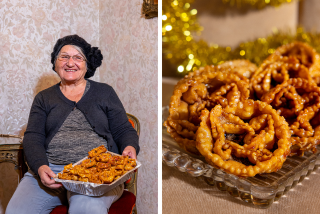Venice the Vivid
- Share via
VENICE, Italy — Venetians think in black and white. They love stark contrast, not only in the facades of their splendid marble palaces and in the masked costumes of Carnival but also on their plates.
On the way to my seat at the Trattoria alla Madonna, a gondola’s hail from the Rialto bridge and near one of the world’s greatest open-air fish markets, I glanced automatically at diners’ plates for hints on the house specialties. A glittering black risotto hit my eye at once. Beside it was a chocolate brown bowl of bean soup. On another table were Venetian-style liver with onions and a game ragu with fluffy white polenta on the side. All these dishes turned out to be pillars of Venetian cuisine.
The risotto nero is made with cuttlefish, the fish first poached in a broth that is then used to cook the rice. The dense black color comes from cuttlefish ink, which also flavors and gives richness. In seppioline nere, the cuttlefish itself is served in an inky sauce, a restorative dish that is traditionally served at weddings, or so an old Venetian chef once assured me with a lewd wink as he stirred the pot.
In the flat, fertile land of the Po delta behind Venice, rice has prospered since it was brought by the Spaniards in the 15th century. The local vialone nano strain of short-grain rice is more highly prized (and more expensive) than the usual arborio. Risotto is made throughout northern Italy, but Venetian cooks declare that theirs is different--softer, creamier, served a l’onda (“on the wave”), in echo of the ripples on their lagoon.
Shellfish, asparagus and other green vegetables are favorite flavorings for risotto, plus a surprising number of dark, contrasting ingredients like black chanterelle mushrooms, ripe olives, raisins, spinach, even nettles and, of course, black truffles found in the local hills.
The oddly white polenta turns out to be another Venetian fad. In contrast to the robust, earthy polenta preferred in most of Italy, here polenta is made with the finely ground flour of white corn, which gives a fluffy, silken finish. Insipid, I thought, though certainly different. Much more to my taste is the bean soup, pasta e fagioli, made with dusky whole-wheat macaroni called bigoli and locally grown brown borlotti beans.
The Venetian curiosity about dark ingredients goes way back. Bigoli are traditional on Good Friday sauced with sardines and anchovy, a salty combination that recalls a Roman fermented fish sauce called garum. In “Banchetti,” a Renaissance cookbook printed in Venice in 1563, Cristoforo di Messisbugo talks of a “black broth” of beef, dark raisins, almonds, cinnamon, honey, onion and bacon. Powerful stuff!
In a pasta shop, I find fettuccine flavored and colored with black olives, cocoa and, of course, squid ink; black ravioli is stuffed with radicchio. The chocolate cakes in the pasticceria are darker and richer than any I’ve seen, while beside them, almond tartlets are snow white with a thick dusting of sugar. I might have guessed that tiramisu, filled with pale mascarpone and topped with dark cocoa, had to have come from Venice. The mug of warming chocolate in the caffe is ebony, topped with white whipped cream. Even my cappuccino is striped with espresso, milky foam and a sprinkling of cocoa powder.
Black is not a comforting color on the plate, and the Venetian pursuit of darkness is a disturbing challenge, though it brings rich rewards. Backed up by the intense flavors of local ingredients, it leads to some wonderful dishes. Here is just one.
RISOTTO WITH GREENS
The darker the greens, the more eye-catching is this risotto. Arugula, broccoli rabe, Savoy cabbage and spinach are all good choices.
GREENS
1 1/2 pounds greens
3 tablespoons olive oil
1 clove garlic, lightly crushed
Salt, pepper
RISOTTO
8 cups chicken stock, more if needed
1/4 cup butter
1 small onion, very finely chopped
2 shallots, very finely chopped
2 cups short-grain rice
1/2 cup dry white wine
2/3 cup (3 ounces) grated Parmesan cheese
GREENS
Discard any tough stems from greens. Wash leaves and any florets and drain in colander.
Heat oil in large skillet. Stir in garlic and saute until just fragrant, about 30 seconds. Add greens and salt and pepper to taste and cook, covered, until tender, stirring occasionally, 5 to 10 minutes, depending on age and type of greens. Taste, adjust seasoning and keep warm.
RISOTTO
Bring stock to boil. Reduce heat and leave to simmer.
Heat 3 tablespoons butter in large heavy saucepan. Add onion and shallots and cook, stirring with wooden spoon, until soft but not brown, 3 to 4 minutes. Stir rice into onion and shallots and saute, stirring until rice begins to turn translucent, 2 to 3 minutes.
Stir in wine and cook until reduced and rice is almost dry. Over medium heat, ladle in about 1 cup stock and simmer, stirring constantly, until almost completely absorbed. Ladle in more stock, working with smaller quantities as rice becomes tender. Continue cooking until rice is very tender and creamy and falls very easily from spoon to form ripples on plate, 20 to 25 minutes.
Remove pan from heat. Stir in remaining 1 tablespoon butter and 1/3 cup cheese. Spoon some risotto into warmed soup bowls. Top with greens and spoon over more risotto. Sprinkle with remaining 1/3 cup cheese. Serve at once.
4 to 6 servings. Each of 6 servings:
513 calories; 1,498 mg sodium; 32 mg cholesterol; 21 grams fat; 58 grams carbohydrates; 20 grams protein; 1.35 grams fiber.
More to Read
Eat your way across L.A.
Get our weekly Tasting Notes newsletter for reviews, news and more.
You may occasionally receive promotional content from the Los Angeles Times.










